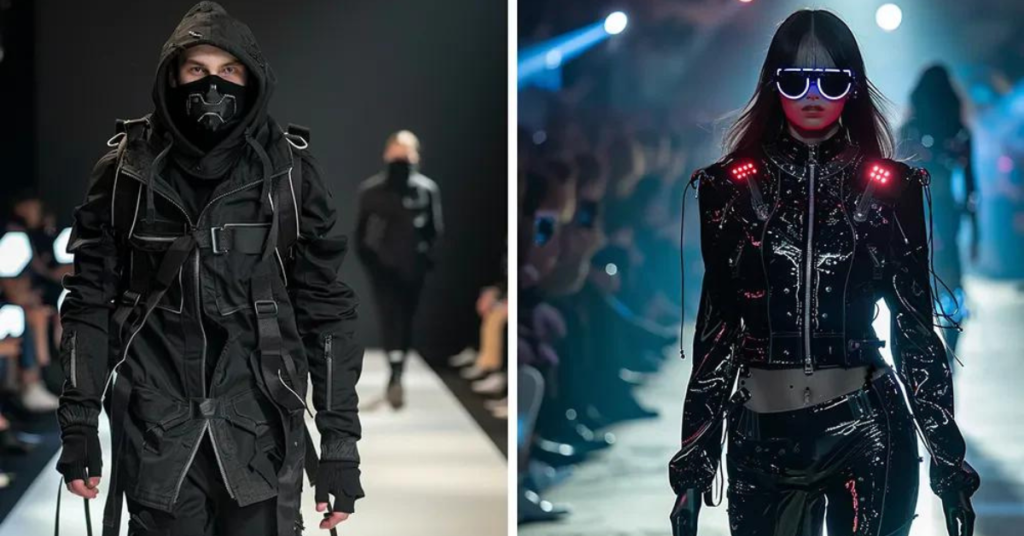Cyberpunk fashion stands as a distinctive and influential aspect of the broader cyberpunk aesthetic. Defined by its blend of futuristic technology and dystopian elements, this fashion style has become a significant cultural phenomenon. Originating from a genre that explores high-tech and low-life, cyberpunk fashion reflects the gritty, neon-lit world envisioned by early creators. In this article, we will delve into the essence of classic cyberpunk fashion, its origins, defining characteristics, and notable examples in media.
The Origins of Cyberpunk Fashion
The Birth of Cyberpunk
Cyberpunk as a genre emerged in the early 1980s, largely defined by William Gibson’s seminal novel “Neuromancer” and Ridley Scott’s film “Blade Runner.” This genre combines advanced technological and cybernetic enhancements with societal decay and urban dystopia. The fashion of this genre evolved to reflect these themes, with a visual language that emphasized the juxtaposition of high-tech and low-life.
Influences from the 1980s
The 1980s saw a surge of interest in futuristic fashion, influenced by the burgeoning technology of the era and the dystopian visions of popular media. Designers like Jean-Paul Gaultier and Vivienne Westwood began to incorporate elements that would later become staples of cyberpunk fashion, such as asymmetrical silhouettes, metallic materials, and a general sense of rebellion against conventional aesthetics.
Defining Characteristics of Cyberpunk Fashion
Futuristic Yet Gritty
Cyberpunk fashion is characterized by its blending of futuristic elements with a worn, gritty appearance. This contrast is evident in the use of materials such as leather, synthetic fabrics, and metallic accents, all of which convey a sense of advanced technology and decay. The aim is to create an aesthetic that feels both cutting-edge and lived-in, reflecting the dystopian environments of cyberpunk narratives.
Layering and Fragmentation
Layering is a key aspect of cyberpunk fashion. Outfits often feature multiple layers, including jackets, vests, and accessories, creating a complex and visually dynamic appearance. This fragmentation not only adds to the futuristic look but also suggests a culture that repurposes and adapts existing materials and garments.
Neon and Synthetic Fabrics
Neon colors and synthetic fabrics are prominent in cyberpunk fashion. Neon lights and holographic effects are hallmarks of the cyberpunk world, and these are mirrored in the use of bright, artificial colors and reflective materials in clothing. Synthetic fabrics, often with a metallic or iridescent finish, enhance the futuristic vibe of the fashion.
Cybernetic Enhancements
A distinctive feature of cyberpunk fashion is the integration of cybernetic elements. This includes accessories that mimic cybernetic implants or enhancements, such as visors, augmented reality glasses, and mechanical prosthetics. These elements emphasize the fusion of human and machine, a central theme in the cyberpunk genre.
Classic Cyberpunk Fashion Icons
The “Blade Runner” Influence
Ridley Scott’s “Blade Runner” is often cited as one of the most influential films in shaping cyberpunk fashion. The film’s depiction of a dystopian future cityscape and its characters’ outfits have become iconic in the genre. Key elements include the use of long, dark trench coats, layered clothing, and a blend of futuristic and vintage styles.
“Neuromancer” and William Gibson
William Gibson’s “Neuromancer” introduced readers to a world where fashion plays a significant role in character development and setting. The novel’s descriptions of characters wearing high-tech gear and street fashion influenced the visual representation of cyberpunk fashion in subsequent media. The term “cyberpunk” itself reflects this fusion of cybernetics and punk aesthetics.
Japanese Cyberpunk and Anime
Japanese cyberpunk media, including anime and manga, has also made significant contributions to the genre’s fashion. Works like “Akira” and “Ghost in the Shell” present unique interpretations of cyberpunk fashion, incorporating elements of Japanese street fashion and futuristic techwear. These influences have helped shape the global perception of cyberpunk aesthetics.
Notable Cyberpunk Fashion Trends
Techwear and Functional Aesthetics
Techwear, a fashion style that emphasizes functionality and technology, aligns closely with cyberpunk aesthetics. It features garments designed with advanced materials and practical functionality, such as waterproof fabrics, modular designs, and numerous pockets. This trend reflects the utilitarian aspect of cyberpunk fashion.
Cyberpunk Streetwear
Streetwear influenced by cyberpunk fashion often includes oversized silhouettes, graphic prints, and distressed materials. Brands like ACRONYM and Off-White have incorporated cyberpunk elements into their collections, blending futuristic designs with contemporary street fashion. This trend highlights the crossover between high fashion and everyday wear in the cyberpunk aesthetic.
Augmented Reality Fashion
With advancements in technology, augmented reality (AR) fashion has emerged as a new frontier in cyberpunk aesthetics. AR fashion includes digital garments and accessories that can be experienced through virtual or augmented reality platforms. This innovation aligns with the cyberpunk theme of merging human experience with advanced technology.
Cyberpunk Fashion in Media
Films and TV Shows
Cyberpunk fashio’n is prominently featured in numerous films and television shows. Notable examples include “The Matrix,” with its sleek black leather outfits and sunglasses, and “Altered Carbon,” which combines futuristic tech with classic noir elements. These media representations continue to influence the evolution of cyberpunk fashio’n.
Video Games
Cyberpunk-themed video games, such as “Cyberpunk 2077” and “Deus Ex,” offer players a chance to immerse themselves in virtual worlds with distinct fashio’n styles. The customization options in these games allow players to experiment with various cyberpunk aesthetics, from high-tech armor to streetwear-inspired outfits.
Music and Culture
Cyberpunk fashio’n has also made its way into music and cultural movements. Artists in the electronic and synthwave genres often embrace cyberpunk aesthetics in their visual presentations, music videos, and album artwork. This crossover highlights the genre’s influence beyond traditional media.
The Future of Cyberpunk Fashion
Evolution and Innovation
As technology continues to advance, cyberpunk fashio’n is likely to evolve alongside it. Innovations in materials, such as smart textiles and adaptive clothing, will shape the future of cyberpunk aesthetics. The genre’s emphasis on high-tech and low-life themes will continue to inspire new fashion trends and creative expressions.
Cultural Integration
Cyberpunk fashion’s integration into mainstream culture and its influence on other genres will further shape its development. The blending of cyberpunk elements with other fashio’n styles and cultural movements will create new and exciting interpretations of the genre’s aesthetic.
Conclusion
Cyberpunk fashio’n remains a captivating and influential aspect of the broader cyberpunk genre. Its unique blend of futuristic technology and gritty urban decay reflects the genre’s core themes and continues to inspire designers, artists, and creators. By exploring the origins, defining characteristics, and notable examples of cyberpunk fashio’n, we gain a deeper understanding of its significance and impact on contemporary culture. As we look to the future, the evolution of cyberpunk fashio’n promises to bring new innovations and interpretations, ensuring its continued relevance and appeal.







